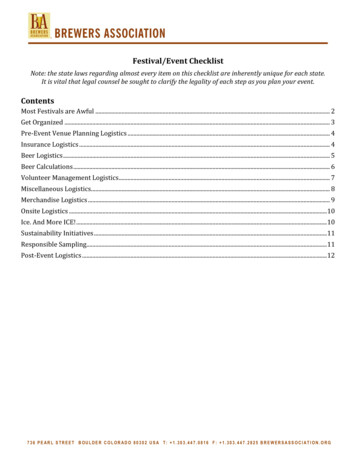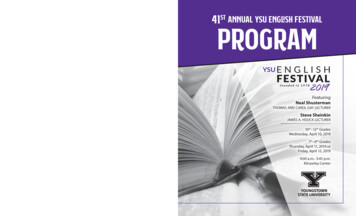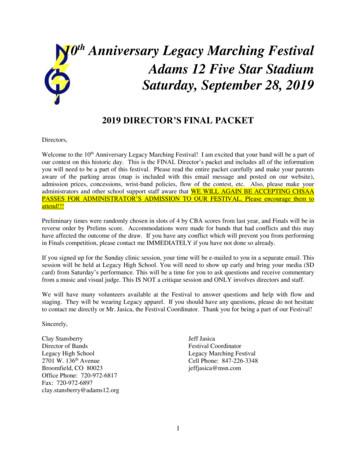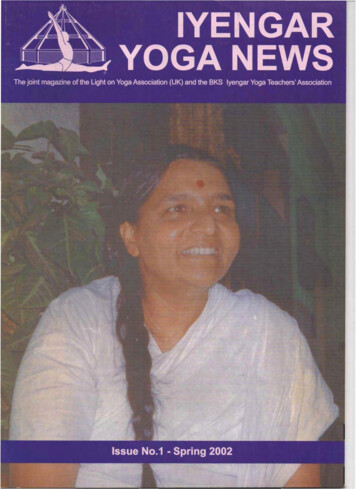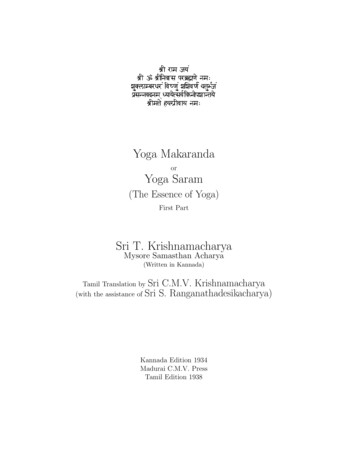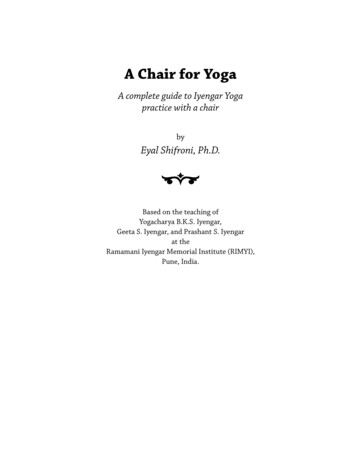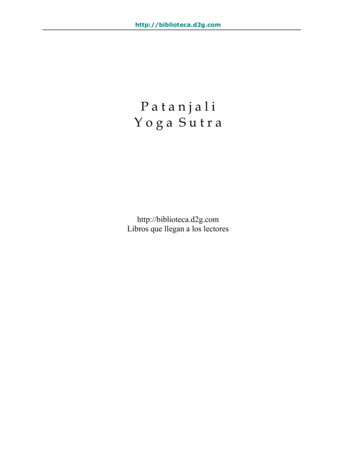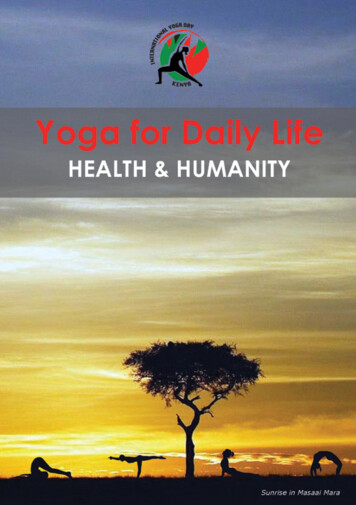
Transcription
Yoga PartnersYoga Supporters
Contents1. What is Yoga? 22. Yogi’s Lifestyle 33. What is SuryaNamaskar (Sun Salutation)?44. Yogasana and its Benefits85. What are Mudras? 156. Pranayama (Rhythmic Control of Breathing)207. Meditation 228. Ayurveda (System of Natural Healing)239. Yoga for Prevention & Cure of Illnesses25PrefaceThis book has been complied to cover the basic yoga practice in one’slife. The booklet is a beginner’s guide to school teachers, students andindividuals at large and is not exhaustive.Sincere thanks to all the organizations, institutes, yoga instructors andindividuals who have voluntarily come and joined the internationalyoga day committee to create awareness about yoga for health andhumanity. Thanks to the members who have put lots of efforts andworked tirelessly since February 2015 when the committee was formed.Thanks to all the members who have supported and worked towardspublishing this booklet.Published in: May 2015AddressHindu Swayamsevak SanghP.O.Box 43967-00100Nairobi, KenyaEmail: info@hsskenya.org1
1.What is Yoga?Yoga is a physical, mental, and spiritual practice or discipline thatdenotes a variety of schools, practices and Individual goals. The bestknown being Hatha yoga and Raja yoga. Practice of Yoga leads to aholistic approach to health and humanity. Yoga postures and consciousbreathing practice has proved to prevent and cure numerous diseasesas well as leading to a happy and healthy life. An individual practicingyoga in its real form and purity is known as a Yogi.The origins of Yoga have been speculated to date back to pre-VedicIndian traditions. The Yoga Sutras of Patanjali from first half of 1stmillennium CE is one of key surviving major texts on Yoga. Hatha yogatexts emerged around 11th century CE. Source: http://en.wikipedia.org/wiki/Yoga. Yoga is a practice for the mankind irrespective of creed,cast or origin and is about an individual and his/her body.Yoga is a complete calming of the movements of the mind. Throughsteady practice and detachment, when the seer-practitioner restrainsthe five mental activities – perceived knowledge, misconception,imagination, sleep and memory, then the seer is established in his ownessential and fundamental nature, then it is Yoga.Saint PatanjaliYoga does not mean some physical postures: twisting oneself into someimpossible postures only. Yoga means to be in perfect tune. Your body,mind and spirit and the existence are in absolute harmony. Whenyou fine-tune yourself to such a point where everything functions sobeautifully within you, naturally the best of your abilities will just flow outof you.Sadguru Jaggi VasudevYoga is the science of activating your inner energies in such a way thatyour body, mind and emotions function at their highest peak.Weight loss, a strong and flexible body, glowing beautiful skin, peacefulmind, good health – whatever you may be looking for, yoga is theanswer.Very often, yoga is only partially understood as being limited to asanas(yoga posture). As such, its benefits are only perceived to be at thebody level and we fail to realize the immense benefits yoga offers inuniting the body, mind and breath. When you are in harmony, thejourney through life is calmer, happier and more fulfilling.2Do you believe, more than 90% of Human population suffer from Stress?Stress relief: At least 15 minutes of yoga during the day can be a greatway to get rid of your stress that accumulates daily - in both the bodyand mind. Yoga postures, pranayama and meditation are effectivetechniques to release stress.
2.Yogi’s LifestyleMany people practice yoga but yoga is not only a soothing workout. Itis also a lifestyle for many people in the world. Below furnished tips willlet you know how to live a “yogic” lifestyle and be at peace with yourinner self.Learn to drink water: Water is the source of all life and so yogis drink this.This is good for fasting, relaxation and yoga. You should drink as muchwater as possible but don’t drink it to the point you feel bloated or evensick. Why not drink a ½ liter to 1 liter in the morning and a glass/mug ofwater every hour you are awake after that?Ideally we should drink one liter of water for every 20kg of your bodyweight. Thus, a person of 60kg should drink minimum of 3 liters of waterper day. Before you start yoga, 15 to 30 minutes, earlier ensure you drinkminimum 250ml of water.Begin practising yoga: Either at home or at a Yoga Class, this is bothenjoyable and relaxing plus it is great to tone up or even lose weight.Remember Yogasana need to be done slowly and with properbreathing technique to be followed at every step.Diet: Vegetarian diet is a Yogi’s diet.“Being a Yogi one should not eat too much, or starve himself/ herself.Yoga is not for the person who sleeps too much, or who doesn’t sleepat all. The middle path is Yoga. The Yogi knows how much to eat, tosleep, to speak. That is the middle path. You should go neither to thatextreme, nor to this extreme. So, don’t abruptly cut off your senses.Allow the senses to enjoy the world, but don’t get carried away withthem. If we know there is a limitation in everything, then life will be goodto us.When dealing with others – A Yogi must have restraints in which nophysical effort is imposed. It is divided into 5 moral injunctions. Ahimsa– Non-violence, Satyam – truthfulness, Brahmacharya – control of allsenses, Asteya – non-stealing, Aparigraha – non-covetousnessWhen dealing with oneself – He/She must impose restraints on oneself.It is divided into 5 ethical precepts.Saucha – internal and externalcleanliness (purity), Santosha – contentment, Tapas – austerity,Swadhyaya – study of the sacred texts, Ishwara Pranidhana –constantly living with awareness of the divine presence3
3.What is SuryaNamaskar (SunSalutation)?Daily practice of Surya Namaskar – the reason for healthy, efficient andenergetic day.Sûrya Namaskâra also known in English as Sun Salutation (“salute to thesun”) is a common sequence of asana (Yoga Postures).It is a combination of 12 physical postures. Its origins lie in India where itslarge population has been showing respect to the SUN by doing SuryaNamaskar and at the same time benefitting from its effects. Withoutthe Sun, there will be no life on Earth as it is the source of Energy. June21 (International Yoga Day), which is the Summer Solstice, is the longestday of the year in the Northern hemisphere, receiving maximum energyfrom the sun and has a special significance in many parts of the world.Surya Namaskar calms the mind and helps to improve concentration.It is a set of 12 postures preferably to be done at the time of sunrise. Itsregular practice improves circulation of the blood throughout the body,maintains health, and helps one remain disease-free. From head to toe,every part of the body is greatly benefitted by Surya Namaskar, which iswhy it is highly recommended by all yoga experts.It revitalizes the body and refreshes the mind, making us ready to take4
on all tasks of the day. When done at a fast pace, Surya Namaskar isan excellent cardiovascular workout and a good way to lose weight aswell.How to perform Surya Namaskara?Every morning during sunrise or within 1hr of Sunrise, is an ideal time toperform Surya Namaskara. On empty stomach drink 120ml of waterbefore you do Surya Namaskara.One has to perfom 12 Surya Namaskara with 12 physical postures asfollows.1 Namaskarasana (Prayer Pose)Stand erect with feet together. Join the palmstogether in front of the chest. Concentrate onstanding straight, steady and in a prayerfulattitude. This posture helps to induce a state ofintroversion, relaxation and calmness. Exhale fully.2 Hasta uttanasana(Raised Arms pose)Inhaling stretch both arms above the head,palms facing upward. Arch the back and stretchthe whole body. It expands the various lobes inthe lungs and puts more oxygen which increasesthe oxygen level in the body.3 Hasta Padasana (Hand to Foot pose)Exhaling bend the body forward and down,keeping the spine straight. Avoid collapsing thechest or “over-rounding” the upper back. Keepthe legs straight and perpendicular to the ground.This posture massages the abdominal organs,especially the liver, kidneys, pancreas, adrenals,uterus and ovaries. The power of digestionincreases and female disorders such as prolapseand menstrual irregularities are relieved. A healthy flow of blood is sentto the spinal nerves as they are stretched and toned. The hamstringmuscles at the back of the thigh and calf muscles are stretched andtoned. Inversion increases blood flow to the brain.5
4 Ashwa Sanchalanasana (Equestrianpose)On your next inhalation, extend the left leg backand drop the knee to the ground. The right kneeis bent and kept between the hands and the rightfoot placed flat on the ground. Lift the spine andopen the chest. Concentrate at the eyebrowcenter. The right leg and left leg are interchangedin the next surya-namaskar set. It opens groin andpsoas muscles improving flexibility of the hips, strengthens knees, ankles,and waist. It is therapeutic for indigestion, constipation, and sciatica.5 Chaturanga Dandasana (Stick pose) orone can do posture 8. On the exhalation bring theright leg back to join with the left leg and keepbody in one plane like a straight stick. It buildsupper and core body strength, lengthens thespine and strengthens the low back muscles.6 Sashtanga Namaskara (Salute With EightParts Or Points)Exhaling gently drop both knees to the groundand slowly slide the body down at an angle asyou bring the chest and chin to the ground. Alleight limbs - toes, knees, chest, hands and chin- touch the floor. The buttocks are kept up. Holdthe breath. This posture develops the chest andstrengthens arms. It sends additional blood to this area helping torejuvenate the nerves.7 Bhujangasana (Cobra pose)On the inhalation, lower the hips while pushing thechest forward and upward with the hands, untilthe spine is fully arched and the head is facingup. The knees and lower abdomen remain abovethe floor. This pose gives dynamic expansion to theorgans of the chest and abdomen, relieving manyailments such as asthma, indigestion, kidney andliver problems. It is very helpful in relieving tensionin the back muscles and spinal nerves.6
8 Parvatasana (Mountain pose)Raise the buttocks and lower the head betweenthe arms, so that the body forms a triangle withthe floor while still keeping the arms and feet inthe same place. Try to place the heels flat on theground. Focus awareness at the neck area. Thisposture strengthens the nerves and muscles inthe arms and legs, stretches the calf muscles andAchilles’ tendons and makes the spine straightand taut. It relieves varicose veins and tones spinalnerves.9 Ashwa Sanchalanasana (Same as asana # 4 but with theother leg forward): Breathe in as you come in this posture.10 Hasta Padasana (Same as asana # 3): Breathe out as youcome to this posture.11 Hasta uttanasana (Same as asana # 2): Breathe in as youcome in this posture.12 Namaskarasana (Same as asana # 1): Retain your breathe,for a few seconds.“A person experiences life as something separated fromthe rest - a kind of optical delusion of consciousness. Ourtask must be to free ourselves from this self-imposed prison,and through compassion, to find the reality of Oneness.”- Albert Einstein -“Yoga is like music: the rhythm of the body, the melodyof the mind, and the harmony of the soul create thesymphony of life.”- B.K.S Iyengar -7
4.Yogasana and its BenefitsThe Yoga postures or physical exercise with correct breathing practiceis called the Yoga Asana which is only one stage of Yoga. There aremore than 500 Asana. Yoga incorporates stretching and relaxation,which reduces tension in stress-carrying muscles. Yoga helps increasestrength in very specific muscles and muscle groups. Many of thepostures in yoga gently strengthen the muscles in the back, as well asthe abdominal muscles. These postures are scientifically chosen as theyflex and energize all muscles respectively in the body in equilibrium.There are basically two ways to classify asanas or yoga poses. Thefirst is according to their names. Some asanas have the name of ananimal, like the Dog Shvanasana, the Snake Bhujangasana, the LocustShalabhasana, the Peacock Mayurasana, the Fish Matsyasana. Otherasanas are named after a sage, like Matsyendrasana (According tolegend, Matsyendra was the first human to hear about Hatha-Yoga),Gorakshasana (Goraksha is the author of the first Hatha-Yoga book, theGoraksha Samhita). Some asanas have the name of a natural form orbeing, like Chandrasana (and Ardha -Chandrasana) the Moon or halfmoon, Vrikshasana the Tree, while others represent a person at differentages, like Balasana, the Child.A second way of classifying poses is according to the position of thebody AND to the position of the spine. Day to day, our bodies assumethree basic positions: Standing (on the legs), Sitting and Reclining. Yogaadds two more: Inverted (upside-down) and Handstanding. Sitting ison our buttocks; Standing is on our feet and eventually, on the knees;Reclining is on our back, stomach or side; Inverted is on our head orshoulders; Handstanding is on our hands and eventually, on the elbows.Standing Postures:Viparita Virabhadrasana (Reverse Warrior Pose)8
Benefits: This posture helps to open the ribs and makes the body moreflexible. It also gives a boost to self-confidence.Steps:Step 1- Stand erect and breathe in.Step 2- Slide your right leg outwards, but both your legs should be in thesame line.Step 3- You can slightly bend your right knee while the left knee shouldbe straight and locked.Step 4- Keep your right hand upwards.Step 5- Bend your right hand towards your left side. Keep in mind thatyour palm should be towards the ceiling.Step 6- Keep your left hand downwards and straight.Step 7- Place your left palm on your left knee.Step 8- Bend your body a little towards your right side.Step 9- Look upwards and keep your br
2. Yogi’s Lifestyle Many people practice yoga but yoga is not only a soothing workout. It is also a lifestyle for many people in the world.
